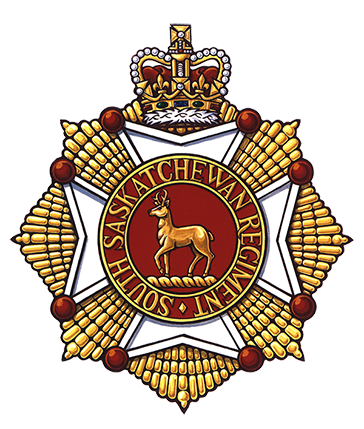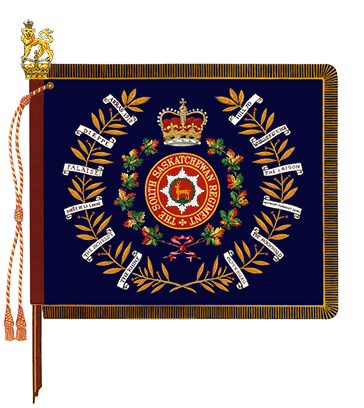The South Saskatchewan Regiment
The official lineage of The South Saskatchewan Regiment infantry regiment.

Badge
Description
On an eight-pointed star Or a Maltese Cross Argent each point pommelled Gules ensigned by the Royal Crown proper and surmounted by a torteau charged with a pronghorn antelope trippant on a wreath Or within an annulus Gules edged and inscribed SOUTH SASKATCHEWAN REGIMENT in letters Or.
Symbolism
The Crown represents service to the Sovereign. The badge is based, in part, on the badges of two British Army regiments to which it was formerly allied. An antelope was bestowed upon The Royal Warwickshire Regiment (now, through amalgamation, The Royal Regiment of Fusiliers) in recognition of their capture in 1701 of a Moorish regiment's Standard, which featured the ancient royal badge of the antelope. Here, the antelope has been replaced by a pronghorn, which is of a different species and native only to North America. The Maltese cross on the eight-pointed star are component parts of The Border Regiment's badge (now, through amalgamation, the Duke of Lancaster's Regiment). "SOUTH SASKATCHEWAN REGIMENT" is a form of the regimental title.
Motto
None
March
"Warwickshire Lads"
Regimental colour

Camp flag
No camp flag recorded.
Battle honours
The First World War
ARRAS, 1917; HILL 70.
The Second World War
Dieppe; BOURGUEBUS RIDGE; St. André sur Orne; FALAISE; Falaise Road; The Laison; Forêt de la Londe; Dunkirk, 1944; Antwerp-Turnhout Canal; THE SCHELDT; Woensdrecht; South Beveland; THE RHINELAND; The Hochwald; Xanten; THE RHINE; Groningen; Oldenburg; NORTH-WEST EUROPE 1942, 1944 45.
Lineage
This Reserve Force regiment originated on 3 July 1905 and incorporates the following regiments.
The South Saskatchewan Regiment originated in Regina, Saskatchewan on 3 July 1905, when a 'regiment of infantry' was authorized to be formed in the districts of Assiniboia and Saskatchewan.Footnote 1 It was redesignated: '95th Regiment' on 2 April 1907;Footnote 2 and '95th Saskatchewan Rifles' on 1 June 1909.Footnote 3 On 1 April 1912, the regiment was reorganized as two separate regiments, designated the '105th Regiment' (now 'The North Saskatchewan Regiment') and the '95th Saskatchewan Rifles'.Footnote 4 On 15 March 1920, it was amalgamated with the '60th Rifles of Canada' (see below) and redesignated 'The South Saskatchewan Regiment'.Footnote 5 On 15 May 1924, The South Saskatchewan Regiment was reorganized into five separate regiments, designated: 'The South Saskatchewan Regiment' (now 'The Saskatchewan Dragoons'); 'The Assiniboia Regiment' (now the '10th Field Artillery Regiment, RCA); 'The Regina Rifle Regiment' (now 'The Royal Regina Rifles'); 'The Weyburn Regiment' and 'The Saskatchewan Border Regiment'.Footnote 6 On 15 December 1936, The Weyburn Regiment and The Saskatchewan Border Regiment were amalgamated and redesignated 'The South Saskatchewan Regiment'.Footnote 7 It was redesignated: '2nd (Reserve) Battalion, The South Saskatchewan Regiment' on 7 November 1941;Footnote 8 and 'The South Saskatchewan Regiment' on 15 December 1945.Footnote 9 It was reduced to nil strength and transferred to the Supplementary Order of Battle on 1 September 1968.Footnote 10
Notes:
Upon redesignation as The South Saskatchewan Regiment on 15 March 1920 (see above), it was organized as a five battalion regiment with the 1st Battalion (28th Battalion, CEF) and 2nd Battalion (46th Battalion, CEF) on the Non Permanent Active Militia order of battle, and the 3rd Battalion (68th Battalion, CEF), 4th Battalion (128th Battalion, CEF), and 5th Battalion (195th Battalion, CEF) on the Reserve order of battle.
On 1 October 1920, it was reorganized as a ten battalion regiment with the 1st Battalion (28th Battalion, CEF), 2nd Battalion (46th Battalion, CEF), 3rd Battalion (no CEF designation), 4th Battalion (no CEF designation), and 5th Battalion (no CEF designation) on the Non Permanent Active Militia order of battle, and the 6th Battalion (68th Battalion, CEF), 7th Battalion (128th Battalion, CEF), 8th Battalion (195th Battalion, CEF), 9th Battalion (no CEF designation) and 10th Battalion (no CEF designation) on the Reserve order of battle (GO 160/20).
The South Saskatchewan Regiment was disbanded for the purpose of reorganization on 1 October 1920 and reorganized the same day (GO 232/20). This change was administrative and does not affect the lineage of the regiment.
Upon reorganization on 15 May 1924 (see above), The Weyburn Regiment was organized as a two battalion regiment with the 1st Battalion (217th Battalion, CEF) on the Non Permanent Active Militia order of battle and the 2nd Battalion (no CEF designation) on the Reserve order of battle. The reserve unit was disbanded on 14 December 1936 (GO 3/37).
Upon reorganization on 15 May 1924 (see above), The Saskatchewan Border Regiment was organized as a two battalion regiment with the 1st Battalion (152nd Battalion, CEF) on the Non Permanent Active Militia order of battle and the 2nd Battalion (no CEF designation) on the Reserve order of battle. The reserve unit was disbanded on 14 December 1936 (GO 3/37).
The Weyburn Regiment and The Saskatchewan Border Regiment were disbanded for the purpose of amalgamation on 1 December 1936 (see above) and reorganized the next day (GO 166/36). This change was administrative and does not affect the lineage of the regiment.
The 60th Rifles of Canada originated in Moose Jaw, Saskatchewan on 2 January 1913, when the '60th Rifles of Canada' were authorized to be formed.Footnote 11 On 15 March 1920, it was amalgamated with the '95th Saskatchewan Rifles', as above.
Perpetuations
'152nd "Overseas" Battalion, CEF'
Headquarters Location
Estevan, Saskatchewan
Operational history
The First World War
Details of the 60th Rifles of Canada were placed on active service on 6 August 1914 for local protective duty.Footnote 12
Details of the 95th Saskatchewan Rifles were placed on active service on 6 August 1914 for local protective duty.Footnote 13
The 152nd Battalion, which was authorized on 22 December 1915 as the '152nd "Overseas" Battalion, CEF',Footnote 14 embarked for Great Britain on 3 October 1916.Footnote 15 Its personnel were absorbed by the '32nd Reserve Battalion, CEF' on 21 October 1916 to provide reinforcements for the Canadian Corps in the field.Footnote 16 The battalion was disbanded on 21 May 1917.Footnote 17
The Second World War
The regiment mobilized 'The South Saskatchewan Regiment, CASF' for active service on 1 September 1939.Footnote 18 It was redesignated '1st Battalion, The South Saskatchewan Regiment, CASF' on 7 November 1940,Footnote 19 and on 15 December 1940 it embarked for Great Britain.Footnote 20 The battalion took part in the raid on Dieppe on 19 August 1942.Footnote 21 It landed again in France on 8 July 1944, as a part of the 6th Infantry Brigade, 2nd Canadian Infantry Division, and it continued to fight in North-West Europe until the end of the war.Footnote 22 The overseas battalion was disbanded on 15 December 1945.Footnote 23